I have just finished reading a very interesting and informative article about Henry VIII and travel. In the article Dr Glen Richardson describes the reasons behind the regular moves made by the court. He states that “Henry usually travelled to hunt, to get to know his kingdom better and to show himself off to his own people and to foreigners alike as a magnanimous and accomplished prince” (Pg. 1).
Even though Henry did a fair amount of travelling he was still the ‘least well-travelled’ of all the European monarchs of his time. He also travelled substantially less than his father, Henry VII, and less than what his daughter, Elizabeth, would during her reign. Each year the king’s travel itinerary would be published along with the names of those who would be accompanying the king. This list was called the ‘giest’.
Over the course of his reign we see Henry travel for necessity and for pleasure. In 1512 a devastating fire forces Henry to leave Westminster and find another principal residence – Greenwich. At Greenwich Henry entertained foreign ambassadors and received high-ranking visitors.
Henry’s palace at Richmond was another place he frequented, regularly entertaining guests at Christmas.
In the 1520’s Henry was often a guest at Cardinal Wolsey’s Hampton Court. A place the king loved so much that in the end Wolsey ‘gave’ it to Henry. After Wolsey’s fall from favour, Henry also ‘acquired’ York Place and eventually transformed it into Whitehall Palace.
Apart from travelling in and around the immediate London area, Richardson states that Henry also travelled in Essex and in the Thames Valley and had “at his disposal over forty larger and smaller residences, most acquired in the decade after 1530” (Pg. 2).
We often imagine the king and court moving around as part of their summer progresses but the king also travelled during the winter months (Richardson, Pg. 2). Dr Richardson states that during the colder months the court housed, fed and entertained more than 1000 people, placing an incredible strain on even the largest of Henry’s houses. The hygiene issues that come with having 1000 people living in the same area and the pressures placed on the resources of the villages supplying the food for the court meant that Henry frequently moved houses.
We are well aware that Henry fled the court at any sign of disease often removing himself to one of his other houses in order to avoid any unpleasant outbreaks. In 1517 after an outbreak of the ‘sweating sickness’ Edward hall reported, “the king kept himself ever with a small company and kept no solemn Christmas, willing to have no resort for fear of infection.” In 1528, we see Henry again travel from house to house in order to avoid another outbreak.
Interestingly, Dr Richardson tells of how Henry also moved houses to “get away” from his court. Often the king would retire to one of his smaller houses with only a select few friends as company. Clearly the stress of being constantly surrounded by courtiers at times got the better of Henry.
Apart from travelling out of necessity or pleasure, Henry also travelled as the nation’s commander-in-chief. In 1512 the king rode to Portsmouth to see his navy; in 1513 Henry led the royal army in an attack against France; in 1544 he captured Boulogne and in 1545 travelled to Portsea to prepare defenses against an invading French Fleet. Here in July he witnessed the sinking of the Mary Rose in the battle of Solent (Richardson, Pg. 2).
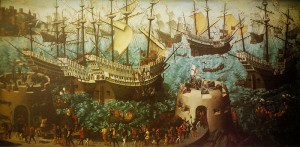
Embarkation of Henry VIII at Dover. A painting that commemorated Henry VIII voyage to the Field of Cloth of Gold in 1520, painted in 1540.
The king not only travelled during times of war, he also travelled during peaceful times to meet other princes. The most spectacular and well know of these progresses occurred in 1520 when Henry travelled to Guines to meet Francis I for the Field of Cloth of Gold. Richardson describes how Henry was accompanied by almost “the entire English nobility and a sizeable proportion of its prominent gentry in an operation second only to war in complexity of its organisation” (Pg. 3).
In 1541 the king made his longest journey, travelling to York to meet James V of Scotland. Unfortunately James never showed and his humiliation was compounded by the fact that his fifth Queen, Catherine Howard, had found adulterous ways of amusing herself during the journey. Needless to say, she soon found herself a prisoner at the Tower of London.
In 1535, Henry VIII embarked on one of the most politically significant progresses of his reign. This progress is of particular interest to me because on this occasion, his second wife, Queen Anne Boleyn, accompanied him. Together they journeyed into the West Country “to promote and oversee the implementation of religious reform there” (Richardson, Pg. 3). Dr Richardson describes the journey:
“Starting from Windsor, the royal party moved to Reading and from there through Oxfordshire to Sudeley Castle in Gloucestershire. They visited another six locations in that county in late August and early September before travelling down through Wiltshire and Hampshire to Southampton, stopping at Winchester en route. In October, after a stay in Portsmouth, Henry headed back towards London through Hampshire staying at Bishop’s Waltham, Old Arlesford and at The Vyne, the home of Lord Sandys, the sheriff of Hampshire, Constable of Southampton Castle and a long time favourite of the king.” (Pg. 3)
Hosting the king and his court was a huge honour but it was also a huge expense! As Nicholas Poyntz found out when he hosted King Henry and Queen Anne in 1535. He built an entire new wing to accommodate the royal guests and bought new plate and porcelain with which to impress them.
Moving the court from place to place was also a huge production. Royal officers left ahead of the royal party and ensured that there was accommodation and provisions for the entire party. This often involved housing members of the ‘outer entourage’ at local inns and private houses in the local area.
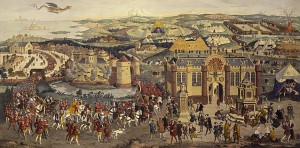
The Field of Cloth of Gold, coloured print by James Basire in 1774, from a 16th century oil painting in the Royal Collection.
Although many of the larger houses had basic furniture and a skeleton staff, the king and queen’s personal belongings, including plate, bed, tapestries and clothes travelled with them. The officers of the Wardrobes of the Robes and Beds were primarily in charge of packing and transporting the goods by “cart, sumpter mule or boat” (Richardson, Pg. 5).
So travel was a way for Henry VIII to see his land, be seen by his people, hunt and another important way for Henry to demonstrate his power and magnificence.
References:
Richardson, G. ‘Henry VIII and Travel’, viewed 23 November 2010,
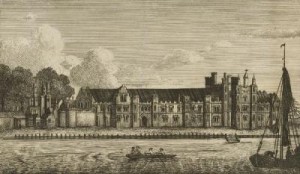
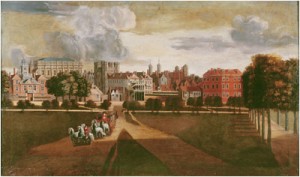
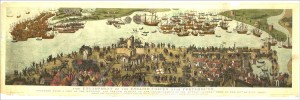
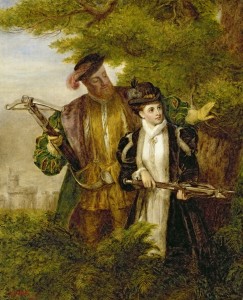
















Yes, the issue of hygiene was an important consideration – the necessity of simply giving the palace or castle an airing after months of habitation, with hundreds of courtiers and visitors coming and going in a space which generally had zero plumbing and sanitation other than the adjacent river or moat. (gentlemen often relieved themselves in any convenient corner, inside or outside of the building). So they had to move on regularly. This was highlighted when Queen Mary went into confinement at Hampton Court around Easter 1555. It was a phantom pregnancy that came to nothing – but no one at first wanted to acknowledge the fact. When the birth never came, the poor Queen stubbornly stayed on at Hampton Court, waiting and waiting in case it should happen – and it was not until August that they finally packed up and left – which put an enormous strain on everybody concerned. The place apparently stunk dreadfully in the hot summer weather.
I can just imagine the smell! Must have been truly terrible.
Their stench to our modern noses would be horrific.
I wonder how often they bathed ?
I like to think that they probably did bathe a lot more than we give them credit for. Even though they did not have our modern conveniences of hot running water and showers, they would still probably have sponged down regularly, and we know that Elizabeth, for instance, had a big bathtub – I think it was copper – that she took with her on her summer progresses, which must have been a nightmare to cart around. (I can’t give your references for any of this, sorry). All this applies to the wealthy, of course, and there would have been all levels of personal hygiene, just as there are today among different families and individuals. But I am sure they would not have lavished such care over their wonderful clothes if they had not also practised some standard of personal grooming as well.
I agree with you Robert and believe that they were a lot more hygiene conscious than what we give them credit for.
There is a humorous story that Queen Elizabeth I would have a bath once a month whether she needed it or not lol!
Carol!
That made me laugh! Thanks.
Hi Natalie,
greetings from a fellow Australia now living and working in Cheshire. I stumbled upon your website whilst doing some research for a Yr4 History class that I teach, very enlightening. I hope you don’t mind me using bits and pieces as background info for my classes.
kind regards,
Peter
Hello Peter! Always lovely to hear from a fellow Aussie! I am also a primary school teacher so there’s another thing we have in common. You are welcome to use information for your history class. A good way to stay up to date with new posts and articles is to sign up to our newsletter and join our Facebook page that I update on a daily basis. We are also on Twitter now. Bye for now!
Peter
Can you email me please as your bigpond address is inactive!
Glad to see that the article on Henry VIII and Travel was interesting to you. Another fellow Aussie here now working and researching in Britain. Good luck with the site.
Hi Glenn, it certainly is interesting! Lovely to meet another Aussie interested in Tudor history. Thanks for saying hello and come back soon! Natalie
I have other articles and papers you could have access to if you wanted. I mainly write on Henry VIII’s court and relations with Francis I. Am writing a new account of the Field of Cloth of Gold which is due out next year. Let me know what you think you would like to build up on Henry and I can see what I have.
I will email you Glenn, thank you very much.